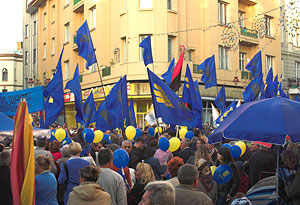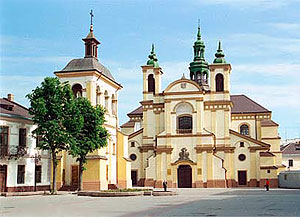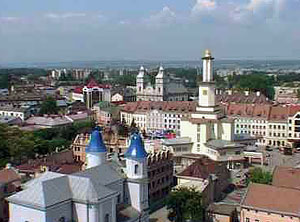- About Ukraine
- The Name of the State
- Geographic Situation
- The Land
- Natural Resources
- The Seas and Inland Waters
- The Climate
- The Flora
- The Fauna
- Administrative and Territorial Organization
- The Population
- Kyiv
- Folk art from Ukraine
- Love Ukraine
- Ivano-Frankivsk region
- Hutsuliya
- Rest and Tourism
- Photograph Album
- Library
- Feed
- Store
This land, where the crystal-clear waters of the Cheremosh, Prut and Bystritsa rivers run through dense forests and mountains, is named after the Ukrainian writer Ivan Franko, the ardent fighter for freedom and author of famous poem «The Eternal Revolutionary». The history of this land recorded in legends and chronicles reflects the dramatic struggle of a freedom-loving people against numerous invaders.
Ancient Galich witnessed the reign of princes Ivan Vasilkovich, Yaroslav Osmomysl, Roman Mstyslavovich and Danilo of Galich, when the people upheld the independence of the Galician-Volhynian principality, which served as the south-west gate to the state of Old Rus. The Batukhan invasion, prolonged enslavement under Polish kings, raids by Turks and the Golden Horde exhausted the Precarpathian land, brought destruction, famine and grief to its inhabitants. And yet, the people always managed to rebuff the invaders. The memory of the people’s military commander Ivan Mukha who, at the head of a peasant army took the towns of Snyatin, Kolomiya, Tismenitsa and Galich remains alive today.

In 1648, during the Ukrainian people’s national-liberation struggle against Polish feudal lords, many towns and villages of the region became centres of the popular uprising led by Semyon Vysochan. The finest representatives of the people Ivan Pisklyvy, Olexa and Ivan Dovbush, Vasil Bayurak, Ivan Boichuk and Miron Shtola headed detachments of people’s avengers. The liberation struggle in the Precarpathian region continued under the rule of Austro-Hungarian emperors which replaced the power of Polish nobility.
The mid-19th, early 20th century were marked by the growth of the revolutionary movement promoted by the bourgeois-democratic revolution in Austria and Hungary and by the dissemination of Marxist ideas. The region was the stage of popular meetings and demonstrations in 1848–1849. A vehement speech by the peasant I. A. Kapushchak made in the Austrian parliament and directed against the oppressors was published by Karl Marx in «Neue Rheinische Zeitung». Under the influence of Ivan Franko, Mikhailo Pavlik and other progressive figures of the time, a galaxy of revolutionary and democratic writers emerged, such as Natalya Kobrinska, Vasil Stefanik, Les Martovich, Marko Cheremshina, and others.
A brief period of peaceful construction was halted by new trials when World War II broke out. The Nazis committed outrages in the temporarily-occupied territory. In July 1941, the underground regional committee of the Comunist Party headed by Yu. S. Beskrovny became active in the region. Underground organizations and partisan detachments were formed in many districts, among them in Zabolotiv and in the village of Zelene. They were headed by patriots such as I. I. Golubtsov, the Komsomol member Yelena Smerechuk, etc.
A major contribution was made in the Creat Patriotic War of 1941–1945 by the heroic partisan detachment commanded by Sidor Kovpak, who made a legendary Carpathian raid, fought on the Dniester, Lomnitsa, Bystritsa, Prut rivers, and broke through enemy lines near Delyatin. Supported by local peasants, Kovpak’s detachment marched through 518 villages. The partisan commissar S. V. Rudnev, Hero of the Soviet Union, fell fighting in the battle near the village of Zarechye. Together with his son Radik and his comrades, who were killed in action during the liberation of the region, he was laid to rest in the town of Yaremcha. This tourist centre now has a Museum of Partisan Glory.
After the war, soldiers, decorated with orders and medals, came home to reconstruct the villages and cities destroyed by the Nazis, and to eradicate bourgeois nationalists and collaborators. Since that time the region has changed beyond recognition. It now boasts an advanced agriculture, modern industrial enterprises, new cities and villages. In August 1967, the Ivano-Frankovsk Region was awarded the Order of Lenin for the labour achievements of the working people of the region in economic and cultural development.
The city of Ivano-Frankivsk, surrounded by new blocks of flats has expanded greatly. Its enterprises include the «Avtolitmash» Plant, and the Fine Organic Synthesis Factory, the Locomotive Repair Works and the Chemical and Steel Framework plants. Products made at the Cementand-Slate Plant, Furniture and the House-Building Combines are in great demand. The «Karpatpressmash» and «Geophyspribor» Production Amalgamations are also well-known in the region. Ivano-Frankivsk is a city of advanced science and education. It boasts a teacher training college and a medical institute, the Institute of Oil and Gas and branches of scientific and research establishments.

The waters of the man-made sea reflect the giant building of the Burshtin Thermoelectric Power Station. Its energy feeds the «Mir» power grid, among others. Kalush, where the «Chlorvinil» Amalgamation alone employs more than 15,000 workers and office employees is often referred to as “the town of chemists”. The Ivano-Frankivsk region is intersected by the «Druzhba» Oil Pipeline, the «Bratstvo». «Soyuz» and Urengoi-Pomary-Uzhgorod gas lines. Oil derricks are an integral part of the Precarpathian landscape.
Old oil-ex trading enterprises have been modernized and a new one in Dolina has been put into operation.
Agricultural machinery produced at Kolomiya operates in the Ukraine, Cuba and Poland. The new «Karpatets» brand loader-excavator is well up to top world standards. Enterprises in Kolomiya make curtains, clothing, footware, rugs and red roofing tiles.
Agriculture in the region is also highly successful. There are more than two hundred collective and state farms in the region. There is a pig-breeding farm in Kalush, poultry farms in Ivano-Frankovsk and Snyatin and numerous green-houses throughout the region.
The residents of Ivano-Frankovsk region are well-known for their love of songs, dances and crafts.
Every spring the village of Verkhny Yaseniv holds a regional folk festival. Numerous guests come here to see amateur theatrical performances and unique folk costumes, and to hear folk tunes of the Carpathian area.
The Hutsul Song and Dance Ensemble, the Berkut, Hutsulochka, Rosinka vocal and instrumental groups, choirs from Gorodenka, Kosiv, Galich and Rogatin are famous for their performances.

The «Veselka» Dance Ensemble of Dolina won the first prize at the Ninth International Art Festival of Folk Groups of Mountainous Areas. The Ivan Franko Music and Drama Theatre has become a real centre of the arts in the region. Today it is housed in a new building designed by a group of architects and artists, who were awarded the Shevchenko State Prize for the project.
The work of local wood-cutters, weavers, leather and metal craftsmen is known for its skill and subtle artistic taste. A secondary arts and craft school which trains young craftsmen, is named after Vasil Kassian, the renowned Ukrainian graphic artist.
The writers Dmitro Pavlichko, Roman Fedoriv and Roman Ivanichuk, the composer Anatoly Kos-Anatolsky and the singer Mariya Stefyuk, People’s Artist of the Ukraine, all of whom started their artistic career in the Ivano-Frankivsk region, are now well-known throughout the country.
The Precarpathian writers Ivan Mikhailyuk, Bogdan Boiko, Pavlo Dobryansky, Halina Turelik, Olexander Smolyan, Neonila Stefurak, Hrigoriy Kirilyuk the folk craftsmen and artists Mykola Varennya, Vasil Vilshuk, Mikhailo Figol, Hanna Vasilashchuk, Paraska Khoma, and People’s Artists of the Ukraine Khristina Fitsalovich and Yuri Surzha are now active in the region. The Museums of Hutsul Folk Art in Kolomiya and Kosiv are genuine treasure-houses of folk art.
The Carpathian landscape, the talents and cordiality of its inhabitants attract tourists from all corners of the world. Sanatoria, hotels and tourist hostels are open all the year round, and tourist routes include picturesque towns and villages, green mountains and the historical sights of the region. Everyone who visits this land is sure to love it.

